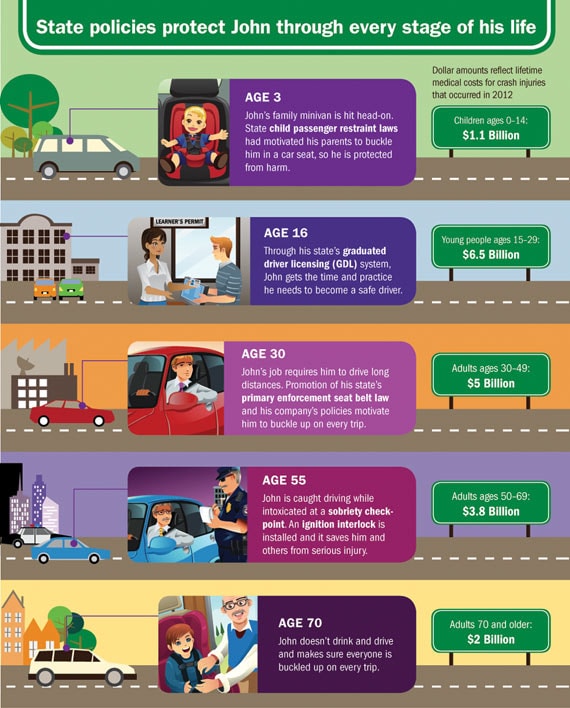The Centers for Disease Control and Prevention (CDC) have just released a new report as part of the CDC’s Vital Signs monthly series regarding motor vehicle accidents in the United States, and the report may be shocking to lots of people. Not only are there a lot of car crashes (along with SUV accidents, and wrecks involving trucks, vans, etc.) in our country, but they cost Americans a tremendous amount in both time and money (not to mention heartache, frustration, pain, and other emotions that were not included in this report).
The numbers are big.
However, also included within this report are some suggestions for new laws to be passed that the CDC suggests will bring these numbers down and decrease the number of traffic accidents in this country: thing is, some of their suggestions may be shocking to some folk. For instance, the CDC would like laws to be passed in every state that requires anyone convicted of any driving under the influence charge (even a first offense) to be required to have ignition interlocks on their vehicles.
What will be the result of the CDC’s suggestions in Indiana, Illinois, or the rest of the country? Time will tell.
However, the real question: if these changes were made, then how much would these accident figures go down?
CDC Report: Costly But Preventable
Read the report, “Motor Vehicle Crash Injuries – Costly but Preventable/October 2014” here.
Among its findings:
- In the United States, people who are injured in a motor vehicle accident spend a total of ONE MILLION DAYS in a hospital for needed treatment.
- Over 2,500,000 accident victims had to seek help in an emergency room after being in a crash in 2012.
- Over their lifetimes, the total financial expense for treating and helping accident victims recover from their injuries totals $18 Billion.
- In 2012 alone, lost wages and lost earnings for these accident victims totalled around $33 Billion.
- Those Americans between 15 and 29 years old are at the high risk of being in a car crash where they will need hospital care.
- Americans over 80 years of age are at the highest risk of needing hospitalization after a traffic accident: 30% of these folk need to go to the hospital after an accident.
From the CDC:
“In 2012, nearly 7,000 people went to the emergency department every day due to car crash injuries,” said CDC Principal Deputy Director Ileana Arias, Ph.D. “Motor vehicle crash injuries occur all too frequently and have health and economic costs for individuals, the health care system, and society. We need to do more to keep people safe and reduce crash injuries and medical costs.”
Fighting To Stop People Being Hurt in Traffic Accidents
There are all sorts of ways to fight against people being hurt in motor vehicle accidents. Things like seat belts and air bags are just two examples of things that have proven successful in keeping people from being seriously injured or killed in a car crash.
CDC Suggestions for New State Laws
However, much more can be done. No state has the exact same laws in effect regarding traffic safety, for one thing. Easy example: compare the motorcycle helmet laws of Indiana and Illinois with states like California, where safety laws are much more strict.
“Motor vehicle crashes and related injuries are preventable,” said Gwen Bergen, PhD, MPH, MS, behavioral scientist in the Division of Unintentional Injury Prevention of the National Center for Injury Prevention and Control. “Although much has been done to help keep people safe on the road, no state has fully implemented all the interventions proven to increase the use of car seats, booster seats, and seat belts; reduce drinking and driving; and improve teen driver safety.”
In the aftermath of its latest research findings, the CDC is encouraging all states to regulate citizens in the following ways:
- Increasing seat belt use through primary enforcement seat belt laws that cover everyone in the car.
- Improving child passenger safety with restraint laws that require car seat or booster seat use for children age 8 and under or until 57 inches tall, the recommended height for proper seat belt fit.
- Reducing drinking and driving by using sobriety checkpoints and requiring ignition interlock use for people convicted of drinking and driving, starting with their first conviction.
- Improving teen driver safety through the use of comprehensive graduated driver licensing systems.
- Supporting traffic safety laws with media campaigns and visible police presence, such as sobriety checkpoints.
- Linking medical and crash data to better understand why crashes happen, the economic cost of those crashes, and how to prevent future crashes.
To help state legislatures make these decisions, the CDC has published its online Motor Vehicle PICCS (Prioritizing Interventions and Cost Calculator for States).
According to the CDC, this online app should help the states tally an estimate for the costs of each suggested implementation and compare that cost against an estimate of lives saved as well as a estimate of the number of injuries that would be prevented with the implementation in that state.


